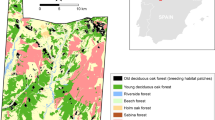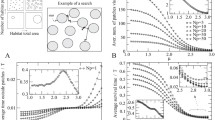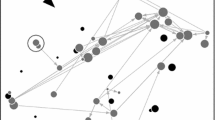Abstract
Dispersal movements, i.e. movements leading to gene flow, are key behaviours with important, but only partially understood, consequences for the dynamics and evolution of populations. In particular, density-dependent dispersal has been widely described, yet how it is determined by the interaction with individual traits, and whether density effects differ between the three steps of dispersal (departure, transience, and settlement), remains largely unknown. Using a semi-natural landscape, we studied dispersal choices of Cornu aspersum land snails, a species in which negative effects of crowding are well documented, and analysed them using dispersal discrete choice models, a new method allowing the analysis of dispersal decisions by explicitly considering the characteristics of all available alternatives and their interaction with individual traits. Subadults were more dispersive than adults, confirming existing results. In addition, departure and settlement were both density dependent: snails avoided crowded patches at both ends of the dispersal process, and subadults were more reluctant to settle into crowded patches than adults. Moreover, we found support for carry-over effects of release density on subsequent settlement decisions: snails from crowded contexts were more sensitive to density in their subsequent immigration choices. The fact that settlement decisions were informed indicates that costs of prospecting are not as important as previously thought in snails, and/or that snails use alternative ways to collect information, such as indirect social information (e.g. trail following). The observed density-dependent dispersal dynamics may play an important role in the ability of C. aspersum to successfully colonise frequently human-disturbed habitats around the world.





Similar content being viewed by others
References
Altwegg R, Collingham YC, Erni B, Huntley B (2013) Density-dependent dispersal and the speed of range expansions. Divers Distrib 19:60–68. doi:10.1111/j.1472-4642.2012.00943.x
Amarasekare P (2004) The role of density-dependent dispersal in source–sink dynamics. J Theor Biol 226:159–168. doi:10.1016/j.jtbi.2003.08.007
Aubry S, Labaune C, Magnin F, Roche P, Kiss L (2006) Active and passive dispersal of an invading land snail in Mediterranean France. J Anim Ecol 75:802–813. doi:10.1111/j.1365-2656.2006.01100.x
Baeza JA (2007) Male mating opportunities affect sex allocation in a protandric-simultaneous hermaphroditic shrimp. Behav Ecol Sociobiol 61:365–370. doi:10.1007/s00265-006-0265-2
Bailey SER (1989) Daily cycles of feeding and locomotion in Helix aspersa. Haliotis 19:23–31
Baillargeon S, Rivest L-P (2007) Rcapture: loglinear models for capture-recapture in R. J Stat Softw 19:1–31. doi:10.18637/jss.v019.i05
Baur A (1993a) Effects of food availability and intra-and interspecific interactions on the dispersal tendency in the land snail Chondrina clienta. J Zool 230:87–100. doi:10.1111/j.1469-7998.1993.tb02674.x
Baur B (1993b) Population structure, density, dispersal and neighbourhood size in Arianta arbustorum (Linnaeus, 1758) (Pulmonata: Helicidae). Ann Naturhist Mus Wiens 94(95):307–321
Benard MF, McCauley SJ (2008) Integrating across life-history stages: consequences of natal habitat effects on dispersal. Am Nat 171:553–567. doi:10.1086/587072
Bitume EV, Bonte D, Ronce O, Bach F, Flaven E, Olivieri I, Nieberding CM (2013) Density and genetic relatedness increase dispersal distance in a subsocial organism. Ecol Lett 16:430–437. doi:10.1111/ele.12057
Bocedi G, Johannes Heinonen, Travis JMJ (2012) Uncertainty and the role of information acquisition in the evolution of context-dependent emigration. Am Nat 179:606–620. doi:10.1086/665004
Bocedi G, Zurell D, Reineking B, Travis JMJ (2014) Mechanistic modelling of animal dispersal offers new insights into range expansion dynamics across fragmented landscapes. Ecography 37:1240–1253. doi:10.1111/ecog.01041
Bonte D, Van Dyck H, Bullock JM, Coulon A, Delgado M, Gibbs M, Lehouck V, Matthysen E, Mustin K, Saastamoinen M, Schtickzelle N, Stevens VM, Vandewoestijne S, Baguette M, Bartoń K, Benton TG, Chaput-Bardy A, Clobert J, Dytham C, Hovestadt T, Meier CM, Palmer SCF, Turlure C, Travis JMJ (2012) Costs of dispersal. Biol Rev 87:290–312. doi:10.1111/j.1469-185X.2011.00201.x
Börger L, Fryxell J (2012) Quantifying individual differences in dispersal using net squared displacement. In: Clobert J, Baguette M, Benton TG, Bullock JM (eds) Dispersal ecology and evolution. Oxford University Press, Oxford, pp 222–230
Bowler DE, Benton TG (2005) Causes and consequences of animal dispersal strategies: relating individual behaviour to spatial dynamics. Biol Rev 80:205–225. doi:10.1017/S1464793104006645
Bride J, Gomot L (1991) Asynchronisme du développement du tractus génital de l’escargot Helix aspersa pendant la croissance et la reproduction. Reprod Nutr Dev 31:81–96. doi:10.1051/rnd:19910108
Brooks SP, Gelman A (1998) General methods for monitoring convergence of iterative simulations. J Comput Graph Stat 7:434–455. doi:10.1080/10618600.1998.10474787
Chaine AS, Legendre S, Clobert J (2013) The co-evolution of multiply-informed dispersal: information transfer across landscapes from neighbors and immigrants. PeerJ 1:e44. doi:10.7717/peerj.44
Chaput-Bardy A, Grégoire A, Baguette M et al (2010) Condition and phenotype-dependent dispersal in a damselfly Calopteryx splendens. PLoS One 5:e10694. doi:10.1371/journal.pone.0010694
Chase R, Pryer K, Baker R, Madison D (1978) Responses to conspecific chemical stimuli in the terrestrial snail Achatina fulica (Pulmonata: Sigmurethra). Behav Biol 22:302–315. doi:10.1016/S0091-6773(78)92366-0
Chevalier L, Desbuquois C, Le Lannic J, Charrier M (2001) Poaceae in the natural diet of the snail Helix aspersa Müller (Gastropoda, Pulmonata). CR Acad Sci Sci Vie 324:979–987. doi:10.1016/S0764-4469(01)01382-8
Clobert J, Le Galliard J-F, Cote J, Meylan S, Massot M (2009) Informed dispersal, heterogeneity in animal dispersal syndromes and the dynamics of spatially structured populations. Ecol Lett 12:197–209. doi:10.1111/j.1461-0248.2008.01267.x
Clobert J, Baguette M, Benton TG, Bullock JM (eds) (2012) Dispersal ecology and evolution. Oxford University Press, Oxford
Cook A (2001) Behavioural ecology: on doing the right thing, in the right place at the right time. In: Barker GM (ed) The biology of terrestrial molluscs. CABI, Wallingford, pp 447–488
Cote J, Clobert J (2007) Social personalities influence natal dispersal in a lizard. Proc R Soc Lond B Biol Sci 274:383–390. doi:10.1098/rspb.2006.3734
Dahirel M, Ansart A, Madec L (2014) Stage- and weather-dependent dispersal in the brown garden snail Cornu aspersum. Popul Ecol 56:227–237. doi:10.1007/s10144-013-0407-0
Dahirel M, Cholé H, Séguret A, Madec L, Ansart A (2015) Context dependence of the olfactory perceptual range in the generalist land snail Cornu aspersum. Can J Zool 93:665–669. doi:10.1139/cjz-2015-0001
Dahirel M, Ansart A, Madec L (2016) Potential syndromes linking dispersal and reproduction in the hermaphrodite land snail Cornu aspersum. J Zool. doi:10.1111/jzo.12328
Dan N (1978) Studies on the growth and ecology of Helix aspersa Müller. PhD thesis, University of Manchester
Dan N, Bailey SER (1982) Growth, mortality, and feeding rates of the snail Helix aspersa at different population densities in the laboratory, and the depression of activity of helicid snails by other individuals, or their mucus. J Molluscan Stud 48:257–265
Davis JM (2008) Patterns of variation in the influence of natal experience on habitat choice. Q Rev Biol 83:363–380. doi:10.1086/592851
De Meester N, Bonte D (2010) Information use and density-dependent emigration in an agrobiont spider. Behav Ecol 21:992–998. doi:10.1093/beheco/arq088
Denny M (1980) Locomotion: the cost of gastropod crawling. Science 208:1288–1290. doi:10.1126/science.208.4449.1288
Doligez B, Danchin E, Clobert J (2002) Public information and breeding habitat selection in a wild bird population. Science 297:1168–1170. doi:10.1126/science.1072838
Dunstan DJ, Hodgson DJ (2014) Snails home. Phys Scr 89:068002. doi:10.1088/0031-8949/89/06/068002
Enfjäll K, Leimar O (2009) The evolution of dispersal—the importance of information about population density and habitat characteristics. Oikos 118:291–299. doi:10.1111/j.1600-0706.2008.16863.x
Gomot L, Enée J (1980) Biologie de la reproduction de l’escargot Helix aspersa Müll.: les phases de croissance et la différenciation sexuelle. Lav Della Soc Malacol Ital 17:73–85
Guiller A, Martin M-C, Hiraux C, Madec L (2012) Tracing the invasion of the Mediterranean land snail Cornu aspersum aspersum becoming an agricultural and garden pest in areas recently introduced. PLoS One 7:e49674. doi:10.1371/journal.pone.0049674
Henry P-Y, Jarne P (2007) Marking hard-shelled gastropods: tag loss, impact on life-history traits, and perspectives in biology. Invertebr Biol 126:138–153. doi:10.1111/j.1744-7410.2007.00084.x
Hovestadt T, Poethke HJ (2006) The control of emigration and its consequences for the survival of populations. Ecol Model 190:443–453. doi:10.1016/j.ecolmodel.2005.03.023
Hovestadt T, Bonte D, Dytham C, Poethke HJ (2012) Evolution and emergence of dispersal kernels—a brief theoretical evaluation. In: Clobert J, Baguette M, Benton TG, Bullock JM (eds) Dispersal ecology and evolution. Oxford University Press, Oxford, pp 211–221
Iglesias J, Castillejo J (1999) Field observations on feeding of the land snail Helix aspersa Müller. J Molluscan Stud 65:411–423. doi:10.1093/mollus/65.4.411
Kim S-Y, Torres R, Drummond H (2009) Simultaneous positive and negative density-dependent dispersal in a colonial bird species. Ecology 90:230–239. doi:10.1890/08-0133.1
Křivan V (2008) Dispersal dynamics: distribution of lady beetles (Coleoptera: Coccinellidae). Eur J Entomol 105:405–409. doi:10.14411/eje.2008.051
Kuefler D, Avgar T, Fryxell JM (2012) Rotifer population spread in relation to food, density and predation risk in an experimental system. J Anim Ecol 81:323–329. doi:10.1111/j.1365-2656.2011.01917.x
Kupfernagel S, Rusterholz H-P, Baur B (2010) Variation in multiple paternity and sperm utilization patterns in natural populations of a simultaneous hermaphrodite land snail. Biol J Linn Soc 99:350–361. doi:10.1111/j.1095-8312.2009.01361.x
Lunn DJ, Thomas A, Best N, Spiegelhalter D (2000) WinBUGS—a Bayesian modelling framework: concepts, structure, and extensibility. Stat Comput 10:325–337. doi:10.1023/A:1008929526011
Marjamäki PH, Contasti AL, Coulson TN, McLoughlin PD (2013) Local density and group size interact with age and sex to determine direction and rate of social dispersal in a polygynous mammal. Ecol Evol 3:3073–3082. doi:10.1002/ece3.694
Mathieu J, Barot S, Blouin M, Caro G, Decaëns T, Dubs F, Dupont L, Jouquet P, Nai P (2010) Habitat quality, conspecific density, and habitat pre-use affect the dispersal behaviour of two earthworm species, Aporrectodea icterica and Dendrobaena veneta, in a mesocosm experiment. Soil Biol Biochem 42:203–209. doi:10.1016/j.soilbio.2009.10.018
Matthysen E (2005) Density-dependent dispersal in birds and mammals. Ecography 28:403–416. doi:10.1111/j.0906-7590.2005.04073.x
Matthysen E (2012) Multicausality of dispersal: a review. In: Clobert J, Baguette M, Benton TG, Bullock JM (eds) Dispersal ecology and evolution. Oxford University Press, Oxford, pp 3–18
May R, van Dijk J, Landa A, Andersen R, Andersen R (2010) Spatio-temporal ranging behaviour and its relevance to foraging strategies in wide-ranging wolverines. Ecol Model 221:936–943. doi:10.1016/j.ecolmodel.2009.12.024
McCarthy MA (2007) Bayesian methods for ecology, 1st edn. Cambridge University Press, Cambridge
Moksnes P-O (2004) Interference competition for space in nursery habitats: density-dependent effects on growth and dispersal in juvenile shore crabs Carcinus maenas. Mar Ecol Prog Ser 281:181–191. doi:10.3354/meps281181
Ng TPT, Saltin SH, Davies MS, Johannesson K, Stafford R, Williams GA (2013) Snails and their trails: the multiple functions of trail-following in gastropods. Biol Rev 88:683–700. doi:10.1111/brv.12023
Nowicki P, Vrabec V (2011) Evidence for positive density-dependent emigration in butterfly metapopulations. Oecologia 167:657–665. doi:10.1007/s00442-011-2025-x
Perrott JK, Levin II, Hyde EA (2007) Morphology, distribution and desiccation in the brown garden snail (Cantareus aspersus) in northern New Zealand. N Z J Ecol 31:60–67
Poethke HJ, Gros A, Hovestadt T (2011) The ability of individuals to assess population density influences the evolution of emigration propensity and dispersal distance. J Theor Biol 282:93–99. doi:10.1016/j.jtbi.2011.05.012
R Core Team (2015) R: a language and environment for statistical computing. R Foundation for Statistical Computing, Vienna
Rémy A, Le Galliard J-F, Odden M, Andreassen HP (2014) Concurrent effects of age class and food distribution on immigration success and population dynamics in a small mammal. J Anim Ecol 83:813–822. doi:10.1111/1365-2656.12184
Rollo CD, Wellington WG (1981) Environmental orientation by terrestrial Mollusca with particular reference to homing behaviour. Can J Zool 59:225–239. doi:10.1139/z81-037
Ronce O (2007) How does it feel to be like a rolling stone? Ten questions about dispersal evolution. Annu Rev Ecol Evol Syst 38:231–253. doi:10.1146/annurev.ecolsys.38.091206.095611
Sæther B-E, Engen S, Lande R (1999) Finite metapopulation models with density–dependent migration and stochastic local dynamics. Proc R Soc Lond B Biol Sci 266:113–118. doi:10.1098/rspb.1999.0610
Schielzeth H (2010) Simple means to improve the interpretability of regression coefficients. Methods Ecol Evol 1:103–113. doi:10.1111/j.2041-210X.2010.00012.x
Selander RK, Kaufman DW (1975) Genetic structure of populations of the brown snail (Helix aspersa). I. Microgeographic variation. Evolution 29:385–401. doi:10.2307/2407252
Serrano D, Oro D, Ursúa E, Tella JL (2005) Colony size selection determines adult survival and dispersal preferences: allee effects in a colonial bird. Am Nat 166:E22–E31. doi:10.1086/431255
Speiser B (2001) Food and feeding behaviour. In: Barker GM (ed) The biology of terrestrial molluscs. CABI, Wallingford, pp 259–288
Spiegelhalter DJ, Best NG, Carlin BP, Van Der Linde A (2002) Bayesian measures of model complexity and fit. J R Stat Soc Ser B Stat Methodol 64:583–639. doi:10.1111/1467-9868.00353
Stamps JA (2001) Habitat selection by dispersers: integrating proximate and ultimate approaches. In: Clobert J, Danchin E, Dhondt A, Nichols J (eds) Dispersal. Oxford University Press, Oxford, pp 230–242
Stamps JA, Krishnan VV, Reid ML (2005) Search costs and habitat selection by dispersers. Ecology 86:510–518. doi:10.1890/04-0516
Starrfelt J, Kokko H (2012) The theory of dispersal under multiple influences. In: Clobert J, Baguette M, Benton TG, Bullock JM (eds) Dispersal ecology and evolution. Oxford University Press, Oxford, pp 19–28
Stratton LW (1964) The non-marine Mollusca of the parish of Dale. Field Stud 2:41–52
Sturtz S, Ligges U, Gelman A (2005) R2WinBUGS: a package for running WinBUGS from R. J Stat Softw 12:1–16. doi:10.18637/jss.v012.i03
Teyke T (1995) Food-attraction conditioning in the snail, Helix pomatia. J Comp Physiol A 177:409–414. doi:10.1007/BF00187477
Tomiyama K, Nakane M (1993) Dispersal patterns of the giant African snail, Achatina fulica (Férussac) (Stylommatophora: Achatinidae), equipped with a radio-transmitter. J Molluscan Stud 59:315–322. doi:10.1093/mollus/59.3.315
Tomlinson J (1966) The advantages of hermaphroditism and parthenogenesis. J Theor Biol 11:54–58. doi:10.1016/0022-5193(66)90038-5
Travis JMJ, Mustin K, Benton TG, Dytham C (2009) Accelerating invasion rates result from the evolution of density-dependent dispersal. J Theor Biol 259:151–158. doi:10.1016/j.jtbi.2009.03.008
Travis JMJ, Mustin K, Bartoń KA, Benton TG, Clobert J, Delgado MM, Dytham C, Hovestadt T, Palmer SCF, Van Dyck H, Bonte D (2012) Modelling dispersal: an eco-evolutionary framework incorporating emigration, movement, settlement behaviour and the multiple costs involved. Methods Ecol Evol 3:628–641. doi:10.1111/j.2041-210X.2012.00193.x
Välimäki P, Itämies J (2003) Migration of the clouded Apollo butterfly Parnassius mnemosyne in a network of suitable habitats–effects of patch characteristics. Ecography 26:679–691. doi:10.1034/j.1600-0587.2003.03551.x
Vardakis M, Goos P, Adriaensen F, Matthysen E (2015) Discrete choice modelling of natal dispersal: “choosing” where to breed from a finite set of available areas. Methods Ecol Evol 6:997–1006. doi:10.1111/2041-210X.12404
Welter-Schultes F (2012) European non-marine molluscs, a guide for species identification. Planet Poster Editions, Göttingen
Acknowledgments
We would like to thank Youn Henry and Alexandre Mounier, who participated in fieldwork. The experimental protocol was greatly improved by comments from Thomas Broquet, Marie-Agnès Coutellec, Blandine Doligez, Annie Guiller, Laurence Henry and Eric Petit. We are grateful to the University of Rennes 1 for allowing us to use part of the Evenière park, and to Thierry Fontaine and Fouad Nassur for their help in preparing and maintaining the experimental meadow. We thank three anonymous reviewers for their comments that helped correct and clarify several aspects of the manuscript.
Author contribution statement
M. D., A. A. and L. M. conceived and designed the experiments. M. D. performed the experiments. M. D. and M. V. analysed the data. M. D. wrote the manuscript, and all other authors provided editorial advice
Author information
Authors and Affiliations
Corresponding author
Ethics declarations
Funding
M. D. was supported by a doctoral grant from the French Ministry of Higher Education and Research. M. V. was supported by a TOP-BOF grant of the University of Antwerp coordinated by Erik Matthysen.
Ethical approval
All applicable institutional and/or national guidelines for the care and use of animals were followed.
Conflicts of interest
The authors declare that they have no conflict of interest.
Additional information
Communicated by Wolf M. Mooij.
Electronic supplementary material
Below is the link to the electronic supplementary material.
Rights and permissions
About this article
Cite this article
Dahirel, M., Vardakis, M., Ansart, A. et al. Density-dependence across dispersal stages in a hermaphrodite land snail: insights from discrete choice models. Oecologia 181, 1117–1128 (2016). https://doi.org/10.1007/s00442-016-3636-z
Received:
Accepted:
Published:
Issue Date:
DOI: https://doi.org/10.1007/s00442-016-3636-z




